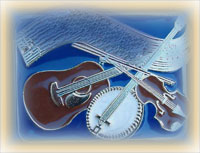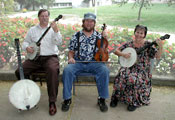The Old 78's and Shitakes: - Carol Anne Rose & Curly Miller - page 2

By Steve Green (Page 2)
Their Musical Beginnings Together
Carole Anne’s move to Arkansas and into Curly’s life came just after Curly started growing shiitake mushrooms, and shortly after, he began his journey into old-time music. Carole Anne began playing guitar with Curly and his friend and band-mate, Pete Howard, joining in their Irish repertoire, and she was especially fascinated by the other band that Curly had just joined, the Skirtlifters. Curly had met and heard the Skirtlifters at the Pumpkin Festival in Osage, Arkansas. The band – Clarke Bueling, Billy Matthews, and Hawk Hubbard – was in need of a bass player willing to travel. Curly mentioned that he had an old Kay plywood bass (named Hermo) and would like to play bowed bass. After he learned their tunes, band practice began in earnest including old-time fiddle tunes, classic banjo pieces, old songs, and minstrel banjo pieces. Their many tours over the years included Brandywine, Piccolo Spoleto, Black Mountain, the Old Town School of Music, and countless more. Personnel changes added Jim Lansford and Pete Howard, allowing Curly to play more mandolin and fiddle. Curly and Carole Anne both loved Clarke’s classic banjo repertoire and began to learn additional banjo pieces that Curly arranged for the two of them. They credit Clarke as being a powerful influence on their exposure to the great sounds of the old-time string bands, and classic and minstrel banjo.
Carole Anne’s Big Banjo
During this time of immersion in old-time music, Carole Anne began to play more banjo and less back-up guitar. Part of the appeal of this instrument change was the distinct and delightful sound of the nylon-strung, skin-head, open-back banjos they prefer. She was playing her Lyon and Healy banjo at the time and remembers the night when she said to Curly, “Why don’t I play this banjo just like I play the guitar, with alternating bass-notes, but clawhammer style?” It worked! Through the years, she continued to develop her skill in this unorthodox style of playing and used it for both their old-time and ethnic repertoire, but often wished for the lower bass notes of the guitar. In the early 1990s during a gig with Norman and Nancy Blake they got the first idea of how to get lower bass notes when Norman told them about Tom Jackson’s five-string-style, six-string banjo, an instrument they were later able to see and play. They were on a banjo quest to John Bernunzio’s in Rochester, New York, in search of some sort of banjo that could be customized into Carole Anne’s “dream banjo.” Spying the 121/2” pot of an old 1893 SS Stewart Banjeaurine lying on John’s desk with a broken neck, they thought that it held promise. Also, they saw possibilities in a fretless minstrel-style H.D. Moulton that hung on the wall. Sensing the culmination of their quest, they brought both banjos back to Arkansas. Bob Momich, a friend who has since relocated from Mountain View, Arkansas, to Hot Springs, North Carolina, agreed to make the custom six-string, five-string-style, short-scale neck. He did a beautiful job creating an SS Stewart reproduction neck. The custom minstrel bridge, tuning, and final voicing of the banjo all turned out to be challenges. While out stacking shiitake logs one day, Curly thought to try tuning the long strings like the top five strings of a guitar, and the twanger (short string) to the low string. This made it playable, although it was always just that slight bit out of tune. Finally, while playing Mexican polkas on his G and C button accordion, Curly thought to tune the banjo a step lower, and suddenly it voiced out beautifully for Carole Anne’s clawhammer style.
Isolation on the Farm
In the early 1990s, the demands of building up the farm and the birth of their son Silas dictated that Curly and Carole Anne would stay close to home. This period of necessary isolation led to the unique sound that we now hear in their band, the Old 78s, and it became a decade-long research project into finding the oldest recordings and sheet music of old fiddle tunes. Curly and Carole Anne discovered an affinity across the years with the lives of the people who actually made the music in the early 20th century, who often did long hours of exhausting physical work daily. Inevitably, their approach to the music reflected the nature of their lives.
During this time of staying close to home, raising three children, and building sweat equity in their farm, Curly and Carole Anne played music locally and in and around the Northwest Arkansas area. Regional concert venues included Branson, Missouri, the Ozark Folk Center in Mountain View, Arkansas, and Six Flags in Dallas, Texas. Closer to home were the monthly dance of the Fayetteville Traditional Dance Society, the annual Dance Festival of the Arkansas Country Dance Society, the weekly dance classes of the McCafferty School of Irish Dance and their annual feis (step dance competition), and Pat Dennis’ Clogging Studios in Springfield, Missouri, as well as concerts, contra dances, and dance weekends in nearby states.
Monthy contra and weekly Irish dances gave them the opportunity to play the tunes they learned from the old recordings, to create dance medleys, and to vary their sound between old-time, Celtic, and other ethnic sources, to the delight of the dancers. They recorded a cassette (no longer available) and three CDs in this time period. Their Camp Meeting CD features their classic banjo repertoire along with old-time music and historic fiddle tunes. I Love This Girl and Horse Shoe Bend are both collections of fiddle tunes from their repertoire including old-time, historic, and old ethnic tunes from various countries. Curly also added tracks of bowed bass to about half the tunes on each CD. (Continued on next page ) 1|2|3
![]()


Steve Green, author of this article, lives near Fayetteville, Arkansas, where he builds individually custom-engineered wheelchairs. Evenings and weekends he can be found calling dances or working on an off-grid cabin not far from Mountain View, Arkansas.
“Old 78’s and Shiitakes: Carole Anne Rose and Curly Miller”by Steve Green was reprinted, with permission, from The Old-Time Herald, a magazine dedicated to old-time music.
More Articles on the The Old 78's |
The Old 78's Recordings |
The Old 78's Videos |
| “Old 78’s and The Cello Banjo
By Paul Roberts |
All the music on The Old 78’s: Old Time Fiddle Rags, Classic and Minstrel Banjo can be previewed at http://cdbaby.com/cd/old78s and purchased there or from The Old 78’s website http://www.theold78s.com |
Jim Nelson, reviewer for THE OLD TIME HERALD, writes:
"From start to finish, this has to be one of the more enjoyable, and unusual selections of dance fiddle music released in quite some time....I suspect that if this duo could be somehow transported back through time about 150 years and plopped down smack dab in the middle of a dance in their neck of the woods, no one would even bat an eye.
 The Old 78's , Classic banjo orchestra music, ragtime and minstrel banjo tunes
The Old 78's , Classic banjo orchestra music, ragtime and minstrel banjo tunesFrom Kingston, Arkansas
Visit their website at http://www.theold78s.com
